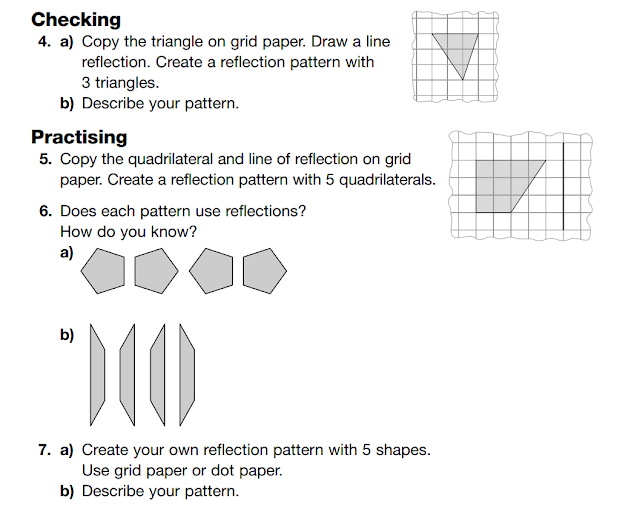
Everyone did VERY well on the quiz on grids and coordinates. BRAVO!
Monday's quiz will focus on reflections, symmetry and identifying and creating reflection patterns. You will be able to use a Mira for the test. Accuracy and preciseness is VERY important in this unit. Make sure you have a sharp pencil and a good ruler to draw straight lines.
Remember how to reflect a shape without a Mira using grid paper or dot paper. Count how far each vertex is from the line of reflection and reflect each vertex. Connect the vertices and your shape should be reflected correctly.
Be able to use a Mira to draw line(s) of symmetry or recognize lines that do not show symmetry.
Know how to create AB reflective patterns and more complex reflective patterns such as ABCD.
Links to dot paper and graph paper:
https://mathbits.com/MathBits/StudentResources/GraphPaper/CentimeterFullPage.pdf
http://www.mathbits.com/MathBits/StudentResources/GraphPaper/DotPaper.pdf?utm_source=www.uoota.com
Make sure you can explain how reflections relate to symmetry:
- A line of reflection is a line of symmetry
- When you reflect a shape you create a symmetrical design
- A reflected shape is identical in both shape and size (congruent)
How can you prove a shape or design is symmetrical?
- Fold it in half and each half fits exactly on top of the other
- Use a Mira to see if the reflection of one half is identical in size, shape, colour to the other half.
Fractions and Decimals
We also linked fractions to decimals less and greater than 1. Again, this concept is very important when we begin our unit on measurement in January. It will also help us understand money. There are four common ways we can show decimals visually. Using a number line, base-ten blocks, money and using metre sticks.
Using base-ten blocks, the hundreds flat represent 1 whole, the tens block 1 tenth and the ones block 1 hundredth.

The decimal would be 1.3
The fraction would be 1 3/10
You would read and write it "one and three tenths" or "one and three one-tenths".
Similarly, 1 metre = 100 cm and 1 metre = 10 decimetres. So 1 dm is one tenth of a metre (0.1) and 1 centimetre is one hundredth of a metre (0.01)
If a frog jumped 1 metre and 6 decimetres.
The decimal would be 1.6 and as metres it would be 1.6 m.
We will keep practicing for the remainder of the week.
Drama
Wonderful performances in our "Drama Circle". Don't be afraid to be creative and EXAGGERATE your actions and words. When you make the audience laugh, that means they are entertained. That's a good thing!
Hmm......what are the odds of us having a snow day this week?
Literacy
In writing, we talked about making meaning clearer. We had some fun sharing some unclear sentences such as.....
There is a bat in the room.
I saw a crane on the way to the park.
I couldn't get my hood up.
Bat, crane, hood are HOMONYMS. Words that sound and are spelled the same way, but have different meanings. HOMOPHONES are words that sound the same, but are spelled differently e.g. night and knight. HOMOGRAPHS are words that are spelled the same but sound differently such as bass (guitar) and bass (fish) or desert (dry area) and desert (to leave).
We can make meaning clear when we write by using STRONG VERBS, DETAIL and DESCRIPTION. It helps the reader VISUALIZE the text.
What is the difference between these sentences?
I saw a bird.
I spotted a robin splashing in a puddle on route to school.
Other than sentence structure, this was probably what was missing the most in your paragraphs describing a scene from a Robert Munsch book.
Reminders:
- Our Christmas Craft Day is on Wednesday.
- Thursday is pajama day and bring your favourite board game.
- Friday is movie day for the school and wear red and green day.
- BRING YOUR MATERIAL FOR YOUR MUSICAL INSTRUMENT ON WEDNESDAY! Remember the thought, design and performance of your instruments will be assessed.
9 more sleeps until Christmas!




No comments:
Post a Comment
Note: only a member of this blog may post a comment.